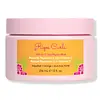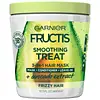What's inside
What's inside
 Key Ingredients
Key Ingredients

 Benefits
Benefits

 Concerns
Concerns

 Ingredients Side-by-side
Ingredients Side-by-side

Water
Skin ConditioningCetyl Alcohol
EmollientStearyl Alcohol
EmollientCapryloyl Glycerin/Sebacic Acid Copolymer
Skin ConditioningDistearyldimonium Chloride
Glycerin
HumectantHeptyl Undecylenate
EmollientCetearyl Alcohol
EmollientHydroxyethylcellulose
Emulsion StabilisingAstrocaryum Murumuru Seed Butter
EmollientCitrus Aurantium Dulcis Peel Oil
MaskingCitrus Paradisi Peel Oil
MaskingButyrospermum Parkii Butter
Skin ConditioningCocos Nucifera Oil
MaskingOlea Europaea Fruit Oil
MaskingPanthenol
Skin ConditioningArgania Spinosa Kernel Oil
EmollientTetrahexyldecyl Ascorbate
AntioxidantCamellia Sinensis Leaf Extract
AntimicrobialPyrus Malus Fruit Extract
Skin ConditioningPolysorbate 20
EmulsifyingPotassium Sorbate
PreservativeEthylhexylglycerin
Skin ConditioningTrisodium Ethylenediamine Disuccinate
Behentrimonium Chloride
PreservativePhenoxyethanol
PreservativeWater, Cetyl Alcohol, Stearyl Alcohol, Capryloyl Glycerin/Sebacic Acid Copolymer, Distearyldimonium Chloride, Glycerin, Heptyl Undecylenate, Cetearyl Alcohol, Hydroxyethylcellulose, Astrocaryum Murumuru Seed Butter, Citrus Aurantium Dulcis Peel Oil, Citrus Paradisi Peel Oil, Butyrospermum Parkii Butter, Cocos Nucifera Oil, Olea Europaea Fruit Oil, Panthenol, Argania Spinosa Kernel Oil, Tetrahexyldecyl Ascorbate, Camellia Sinensis Leaf Extract, Pyrus Malus Fruit Extract, Polysorbate 20, Potassium Sorbate, Ethylhexylglycerin, Trisodium Ethylenediamine Disuccinate, Behentrimonium Chloride, Phenoxyethanol
Water
Skin ConditioningCetearyl Alcohol
EmollientGlycerin
HumectantIsopropyl Myristate
EmollientStearamidopropyl Dimethylamine
EmulsifyingButyrospermum Parkii Butter
Skin ConditioningOlea Europaea Fruit Oil
MaskingGlycine Soja Oil
EmollientSodium Hydroxide
BufferingRosmarinus Officinalis Leaf Extract
AntimicrobialCoco-Caprylate/Caprate
EmollientCocos Nucifera Oil
MaskingHydroxypropyl Guar Hydroxypropyltrimonium Chloride 2%
Citric Acid
BufferingTartaric Acid
BufferingCetyl Esters
EmollientCaramel
Cosmetic ColorantParfum 2%
MaskingWater, Cetearyl Alcohol, Glycerin, Isopropyl Myristate, Stearamidopropyl Dimethylamine, Butyrospermum Parkii Butter, Olea Europaea Fruit Oil, Glycine Soja Oil, Sodium Hydroxide, Rosmarinus Officinalis Leaf Extract, Coco-Caprylate/Caprate, Cocos Nucifera Oil, Hydroxypropyl Guar Hydroxypropyltrimonium Chloride 2%, Citric Acid, Tartaric Acid, Cetyl Esters, Caramel, Parfum 2%
 Reviews
Reviews

Ingredients Explained
These ingredients are found in both products.
Ingredients higher up in an ingredient list are typically present in a larger amount.
This ingredient is also known as shea butter. It is an effective skin hydrator and emollient.
Emollients help soothe and soften your skin. It does this by creating a protective film on your skin. This barrier helps trap moisture and keeps your skin hydrated. Emollients may be effective at treating dry or itchy skin.
Shea butter is rich in antioxidants. Antioxidants help fight free-radicals, or molecules that may harm the body. It is also full of fatty acids including stearic acid and linoleic acid. These acids help replenish the skin and keep skin moisturized.
While Shea Butter has an SPF rating of about 3-4, it is not a sunscreen replacement.
Shea butter may not be fungal acne safe. We recommend speaking with a professional if you have any concerns.
Learn more about Butyrospermum Parkii ButterCetearyl alcohol is a mixture of two fatty alcohols: cetyl alcohol and stearyl alcohol. It is mainly used as an emulsifier. Emulsifiers help prevent the separation of oils and products. Due to its composition, it can also be used to thicken a product or help create foam.
Cetearyl alcohol is an emollient. Emollients help soothe and hydrate the skin by trapping moisture.
Studies show Cetearyl alcohol is non-toxic and non-irritating. The FDA allows products labeled "alcohol-free" to have fatty alcohols.
This ingredient is usually derived from plant oils such as palm, vegetable, or coconut oils. There is debate on whether this ingredient will cause acne.
Due to the fatty acid base, this ingredient may not be Malassezia folliculitis safe.
Learn more about Cetearyl AlcoholCocos Nucifera Oil is obtained from the kernels of the coconut fruit. In other words, this is coconut oil.
Coconut Oil is rich in fatty acids with lauric acid making up the majority of these. It also contains linoleic acid. Due to this high fatty acid content, coconut oil helps trap moisture and soften skin.
Despite being antibacterial, coconut oil may not be great for acne-prone skin. It is comedogenic and may clog pores. This ingredient may not be safe for malassezia or fungal acne.
Note: Coconut Oil should not replace your sunscreen for UV protection. Studies show it only blocks about 20% of UV.
This oil is non-volatile and has a light scent.
The term 'fragrance' is not regulated in many countries. In many cases, it is up to the brand to define this term. For instance, many brands choose to label themselves as "fragrance-free" because they are not using synthetic fragrances. However, their products may still contain ingredients such as essential oils that are considered a fragrance.
Learn more about Cocos Nucifera OilGlycerin is already naturally found in your skin. It helps moisturize and protect your skin.
A study from 2016 found glycerin to be more effective as a humectant than AHAs and hyaluronic acid.
As a humectant, it helps the skin stay hydrated by pulling moisture to your skin. The low molecular weight of glycerin allows it to pull moisture into the deeper layers of your skin.
Hydrated skin improves your skin barrier; Your skin barrier helps protect against irritants and bacteria.
Glycerin has also been found to have antimicrobial and antiviral properties. Due to these properties, glycerin is often used in wound and burn treatments.
In cosmetics, glycerin is usually derived from plants such as soybean or palm. However, it can also be sourced from animals, such as tallow or animal fat.
This ingredient is organic, colorless, odorless, and non-toxic.
Glycerin is the name for this ingredient in American English. British English uses Glycerol/Glycerine.
Learn more about GlycerinOlea Europaea Fruit Oil is the fixed oil obtained from the ripe fruit of the Olive. In other words - olive oil.
The primary contents of olive oil are glycerides of the fatty acids linoleic, oleic and palmitic.
Olive oil also contains antioxidants such as Vitamin E. Antioxidants may help reduce signs of aging by fighting unstable free-radical molecules. It also contains Vitamins A (retinol), D, and K.
The squalene in olive oil makes it a great emollient. Emollients help soothe and soften your skin by trapping moisture in. This makes olive oil a great skin moisturizer.
Studies show olive oil to have antibacterial and antifungal properties in low concentrations. Another study found olive oil irritated sensitive oily skin. We always recommend speaking with a professional about using this ingredient in your routine.
Due to the fatty acid content, this ingredient may not be fungal-acne safe.
Learn more about Olea Europaea Fruit OilWater. It's the most common cosmetic ingredient of all. You'll usually see it at the top of ingredient lists, meaning that it makes up the largest part of the product.
So why is it so popular? Water most often acts as a solvent - this means that it helps dissolve other ingredients into the formulation.
You'll also recognize water as that liquid we all need to stay alive. If you see this, drink a glass of water. Stay hydrated!
Learn more about Water